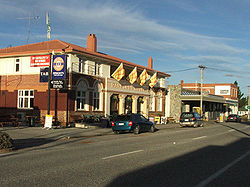Ranfurly, New Zealand
| Ranfurly | |
|---|---|
| Settlement | |

The main street of Ranfurly
|
|
| Location of Ranfurly within New Zealand | |
| Coordinates: 45°08′S 170°06′E / 45.133°S 170.100°ECoordinates: 45°08′S 170°06′E / 45.133°S 170.100°E | |
| Country | New Zealand |
| Region | Otago |
| Territorial authority | Central Otago District Council (see Alexandra) |
| Population (2006 census) | |
| • Urban area | 1,060 |
| Time zone | NZST (UTC+12) |
| • Summer (DST) | NZDT (UTC+13) |
Ranfurly is the largest settlement in the Maniototo district of Otago, New Zealand. Located 110 kilometres north of Dunedin, it lies in dry rough country at a moderately high altitude (around 430 metres above sea level) close to a small tributary of the Taieri River. It operates as a service town for the local farming community. The town was formerly known as Eweburn, one of the "farmyard" names bestowed by former Otago Chief Surveyor John Turnbull Thomson on many small streams and locations in the district. The modern name honours the Fifth Earl of Ranfurly, who served as Governor of New Zealand (1897-1904) at the time of the extension of the Otago Central Railway to the area.
Under the Köppen climate classification Ranfurly has an oceanic climate (Cfb).
Central Otago in general, and the Maniototo in particular, has one of New Zealand's very few zones influenced by continental-climates, with large daily and seasonal temperature extremes. Average highs in summer are around 22 °C (72 °F), with occasional days as warm as 30 °C (86 °F); average winter highs are around 7 °C (45 °F), with the coldest nights below −5 °C (23 °F). The lowest temperature on record in New Zealand (-25.6 °C) was recorded at Ranfurly in 1903. Heavy frosts are common throughout winter.
The town is sheltered from the prevailing rain patterns by the mountains to the west. The Nor'wester foehn wind is thus a frequent weather pattern, and annual rainfall is only in the region of 300-400mm.
During the Central Otago goldrush of the 1860s, several important deposits of the precious metal were found near Ranfurly, notably at Kyeburn and Naseby, close to the southwestern face of the Kakanui Range.
...
Wikipedia

